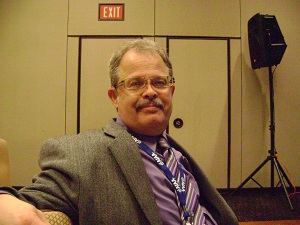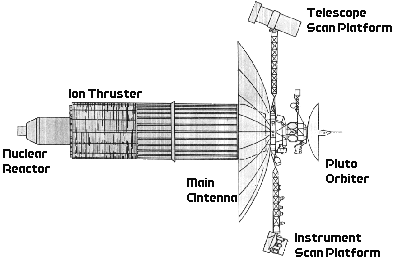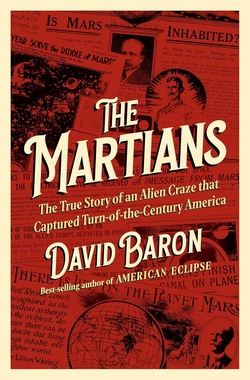Centauri Dreams
Imagining and Planning Interstellar Exploration
Primordial Origins of (Some) of Earth’s Water
With one interstellar conference in the books for 2014, I’ll be headed next for the Tennessee Valley Interstellar Workshop, whose upcoming gathering will be held in Oak Ridge this November. Last week’s coverage of the 100 Year Starship Symposium in Houston has allowed several interesting stories to back up in the queue, and I’ll spend the next few days going over some of the latest findings, starting with the discovery that a large fraction of the water in Earth’s oceans may be substantially older than we think. The results make a strong case for water as a common ingredient in planet formation no matter where the planet forms or around what kind of star.
Ilsedore Cleeves (University of Michigan) is lead author on the new paper in Science that argues the case. What Cleeves and colleagues have found is that up to half of the water in our Solar System formed before the Sun itself emerged from the primordial gas and dust cloud that gave it birth. That encompasses more than the Earth’s oceans, of course, because we know that water is found in places as widely disparate as Mercury, the Moon, on comets, and on the moons of gas giants. The question the new work answers is the sequence in which that water forms. Cleeves explains the issue:
“There has been a long-standing question as to whether any of these ancient ices, including water, are incorporated into young planetary systems, or if all the pre-planetary building blocks are reprocessed and/or locally synthesized near the star.
“These two scenarios have very different consequences for the composition of planets. In the latter case, the chemical make-up of the planets, including water, would depend upon what type of star a planet ends up next to. In contrast, the former case implies that all planetary systems would form from similar starting materials, including abundant interstellar water.”

Image: How common are views like this in the galaxy? New work out of the University of Michigan indicates that water in the interstellar medium survives solar system formation and can contribute to the planets that emerge, an opportunity available to all nascent stellar systems.
The researchers studied the question using deuterium, or heavy hydrogen, which is an isotope of hydrogen with a proton and a neutron in the nucleus (ordinary hydrogen has no neutron in the nucleus). On the Earth, deuterium’s abundance is one atom for every 6,420 of hydrogen. This ratio, found not only on Earth but also in comets, is higher than the ratio in the Sun. In fact, deuterium-enriched water should form at temperatures only 10 degrees above absolute zero. Ted Bergin, a University of Michigan astronomer, explains the implication:
“Chemistry tells us that Earth received a contribution of water from some source that was very cold — only tens of degrees above absolute zero, while the Sun being substantially hotter has erased this deuterium, or heavy water, fingerprint.”
Simulating chemical evolution in a planetary disk over a million year period, Cleeves found that the processes at work in the disk were insufficient to make the heavy water that exists throughout the Solar System. Thus the first scenario above is likely — the planetary disk didn’t make all the system’s water but acquired much of it from elsewhere. Deuterium enrichment happens not only under cold temperatures but in the presence of oxygen and ionizing radiation. All of these are found in the interstellar medium, where the radiation is provided by cosmic rays, and deuterium-enriched water has indeed been observed in the ISM.
Like the interstellar medium, the young planetary disk would also offer up radiation, even if the cosmic ray count would drop because of the growing star’s magnetic field and stellar wind. But the process cannot yield heavy water in the amounts needed. From the paper:
With our updated disk ionization model, we can now exclude chemical processes within the disk as an enrichment source term and conclude that the solar nebula accreted and retained some amount of pristine interstellar ices. One potential explanation is that during the formation of the disk, there was an early high temperature episode followed by continued infall from deuterium-enriched interstellar ices.
The numbers that flow out of this work show that 30 to 50% of the water in Earth’s oceans and between 60 to 100% of the water in comets comes from water predating the Sun, arriving as interstellar ices that survived the Solar System’s formation and were incorporated into the various planets and other bodies. The implication is that a fundamental prerequisite for life as we know it is available to all planetary systems in formation. Water is ‘inherited’ from the immediate environment of an emerging planetary system and is therefore widespread elsewhere in the universe, locked up in the ices, gas and dust circling the infant star.
The paper is Cleeves et al., “The ancient heritage of water ice in the solar system,” Science Vol. 345, No. 6204 (26 September 2014), 1590-1593 (abstract / preprint). See also Daniel Clery’s summation in the same issue of Science. Clery quotes Karen Willacy (JPL), who places the new study in context:
“This is a very interesting result. We’ve been debating this for years, whether or not the ices have an interstellar heritage”… She says that other groups have tried to model the collapse of clouds in the ISM into planetary systems to see if ice would survive, but “with various results, that don’t always agree,” Willacy says. “This is much more simple approach, just using the chemistry which is well understood.”
This news release from the University of Exeter is also helpful.

Closing Out 100YSS: Antimatter, Gravitational Lensing & a Modified Orion
I don’t envy the track chairs at any conference, particularly conferences that are all about getting large numbers of scientists into the right place at the right time. Herding cats? But the track model makes inherent sense when you’re dealing with widely disparate disciplines. Earlier in the week I mentioned how widely the tracks at the 100 Year Starship Symposium in Houston ranged, and I think that track chairs within each discipline — already connected to many of the speakers — are the best way to move the discussion forward after each paper.

Still, what a job. My friend Eric Davis, shown at right, somehow stays relaxed each year as he handles the Propulsion & Energy track at this conference, though how he manages it escapes me, given problems like three already accepted presentations being withdrawn as the deadline approached, and one simple no-show at the conference itself. Unfortunately, there were no-shows in other tracks as well, though the wild weather the night before the first day’s meetings may have had something to do with it.
Processes will need to be put in place before future symposia to keep this kind of thing from happening. Fortunately, Eric is quick on his feet and managed to keep Propulsion & Energy on course, and I assume other track chairs had their own workarounds. A high point of the conference was the chance to have dinner and a good bottle of Argentinian Malbec with Eric and Jeff Lee (Baylor University), who joined my son Miles and myself in the hotel restaurant.
The Antimatter Conundrum
I found two papers on antimatter within Eric’s track particularly interesting given the challenge of producing antimatter in sufficient quantity to make it viable in a future propulsion system. We’d love to master antimatter because of the numbers. A fusion reaction uses maybe one percent of the total energy locked up inside matter. But if you can annihilate a kilogram of antimatter, you can produce ten billion times the energy of a kilogram of TNT. In nuclear energy terms, the antimatter yields a thousand times more energy than nuclear fission, and 100 times more energy than fusion, a compelling thought for interstellar mission needs.
Sumontro Lal Sinha described the requirements for a small, modular antimatter harvesting satellite that could be launched into the Van Allen radiation belt about 15,000 kilometers up. I was invariably reminded of James Bickford’s ideas on creating an antimatter trap in an equatorial orbit around the Earth that could harvest naturally occurring antiparticles — Bickford has always maintained that space harvesting of antimatter using his ‘magnetic scoop’ is five orders of magnitude more cost effective than producing antimatter on Earth. In any case, antimatter resources here and elsewhere in the Solar System offer useful options.
Remember that the upper atmosphere of the planets is under bombardment from high-energy galactic cosmic rays (GCR), which results in ‘pair production’ as the kinetic energy of the GCR is converted into mass after collision with another particle. Out of this we get an elementary particle and its antiparticle. Planets with strong magnetic fields become antimatter sources because particles interact with both the magnetic field and the atmosphere. Sinha’s harvester would be an attempt at pair-production that he describes as lightweight and modular. I haven’t seen a paper on this one so I can’t go into useful detail. I’ll hope to do that later.
Storing macroscopic amounts of antimatter for propulsion purposes is the other side of the antimatter conundrum, an issue tackled by Marc Weber (Washington State), who described long antimatter traps in the form of stacks of wafers that essentially form an array of tubes. Storage is an extreme issue because like charges repel, so that large numbers of positrons, for example, generate repulsive forces that magnetic bottles cannot fully contain. Weber’s long traps are in proof-of-principle testing as he tries to push storage times up.

Image: One of Marc Weber’s slides, illustrating principles behind a new kind of magnetic storage trap for antimatter.
Thermonuclear Propulsion and the Gravitational Lens
It’s always a pleasure to see old friends at these events, and I was happy to have the chance to share breakfast with Claudio Maccone, whose long-standing quest to see the FOCAL mission built and flown has come to define his career. But in addition to speaking about the gravitational lens at 550 AU and beyond, Claudio was in Houston to discuss the Karhunen-Loève Transform (KLT), developed in the 1940s to improve sensitivity to artificial signals by a large factor, another idea he has long championed. The idea here is that the KLT has SETI applications, helping researchers in the challenging task of sifting through signals that may be spread through a wide range of frequencies.
Consider our own civilization’s use of code division multiplexing. Mason Peck was also talking about this at the conference — the reason you can use your cellphone in a conversation is that multiple access methods (code division multiple access, or CDMA) allows several transmitters to send information simultaneously though using the same communications channel. Spread-spectrum methods are at work — the signal is sent over not one but a range of frequencies — and you’re actually dealing with a combination of many bits that acts like a code. If we’re using these methods, perhaps a signal we receive from an extraterrestrial civilization may be as well, and perhaps the best way to unlock it is to use the KLT.
I missed Claudio’s session on the KLT but was able to be there for his talk on using the gravitational lens as a communications tool. Beyond the propulsion question, one of the biggest problems with putting a probe around another star is data return. How do we get a workable signal back to Earth? Fortunately, the gravitational lens can offer huge gains by employing the focusing power of the Sun on electromagnetic radiation from an object on the other side of it. Using conventional radio communications would require huge antennae and substantial (and massive) resources aboard the probe itself. These would not be necessary if we fly the needed precursor mission to the distances needed to use the gravitational lens.
Thus we send a relay spacecraft not toward Alpha Centauri but in exactly the opposite direction. Ordinary radio links can be easily maintained. If we tried conventional methods using a typical Deep Space Network antenna and a 12-meter antenna aboard the spacecraft (assuming a link frequency in the Ka band, or 32 GHz, a bit rate of 32 kbps, and 40 watts of transmitting power), we still get a 50 percent probability of errors. A relay probe at the gravitational lens, however, shows no bit error rate increase out to fully nine light years.

I’m moving quickly here and I can’t go through each presentation, but I do want to mention as well Friedwardt Winterberg’s talk on thermonuclear propulsion options. Dr. Winterberg has a long history in researching nuclear rocketry, dating back to the days of Ted Taylor, Freeman Dyson, and the era of Project Orion (which he could not join because he was not yet a US citizen). The Atmospheric Test Ban Treaty of 1963 was one of the factors that put Orion to rest, but Fred has been championing nuclear micro-bombs with non-fission triggers, an idea he first broached at a fusion workshop all the way back in 1956. His most recent paper reminds us of von Braun’s ideas about assembling a huge fleet in orbit for the exploration of Mars:
A thermonuclear space lift can follow the same line as it was suggested for Orion-type operation space lift, but without the radioactive fallout in the earth atmosphere. With a hydrogen plasma jet velocity of 30 km/s, it is possible to reach the orbital speed of 8 km/s in just one fusion rocket stage, instead of several hundred multi-stage chemical rockets, to assemble in space one Mars rocket, for example. .. The launching of very large payloads in one piece into a low earth orbit has the distinct advantage that a large part of the work can be done on the earth, rather than in space.
Exactly how to ignite a thermonuclear micro-explosion by a convergent shockwave produced without a fission trigger is the subject of the new paper, and I’m looking for someone more conversant with fusion than I am to give it a critical reading to be reported here. The basic Orion concept remains in Winterberg’s work with fission bombs replaced by deuterium-tritium fusion bombs being set off behind a large magnetic mirror rather than Orion’s pusher plate.
All Too Little Time
So many papers occurred in different tracks at conflicting times, exacerbated by the need to attend advisory board meetings, so I missed out on a number of good things. I wish I could have attended Kathleen Toerpe’s entire Interstellar Education track, and there were sessions in Becoming an Interstellar Civilization and Life Sciences in Interstellar that looked very promising. I hope in the future the conference organizers will set up video recording capabilities in each track, so that attendees and others can catch up on what they missed.
Several upcoming articles will deal with subjects touched on at 100YSS. Al Jackson is writing up his SETI ideas using extreme astronomical objects, and I’ll be talking about Ken Wisian’s paper on military planning for interstellar flight — Ken and his lovely wife joined Heath Rezabek, Al Jackson, Miles and myself for dinner. The conversation was far-ranging but unfortunately the Friday night restaurant scene was noisy enough that I missed some of it. Miles and I stopped down the street the next night at the Guadalajara, a good Mexican place with a quiet upstairs bar. Great margaritas, and a fine way to close out the conference. Expect an upcoming article from Miles, shown below, on his recent interstellar presentation in a seriously unconventional venue. I’m giving nothing away, but I think you’ll find it an encouraging story.


100YSS: An Encouraging Future for Sails
India can take great pride in the successful insertion of its Mangalyaan Mars probe into orbit around the red planet. At a cost of $75 million, the spacecraft is a bargain — Maven, which entered Mars orbit on Sunday, cost almost ten times as much. In an Associated Press story this morning, I noticed that B. N. Raghunandan (Indian Institute of Science) said that every time India launches another rocket, he is besieged with students asking how they can enter his school’s aerospace program. It’s the same effect I was talking about yesterday, in which inspirational achievements drive cultural perceptions and influence careers.
Meanwhile, I want to tackle solar sails this morning, prompted by Les Johnson’s presentation at the 100 Year Starship Symposium in Houston last week. What caught my attention here was the positive news Les had to share about what’s ahead in the pipeline. But to put it into context, let’s think about what has already flown in space. The Russian ‘sail mirror’ experiments called Znamya were pitched as an attempt to light up Siberian cities at night, but of course can be considered experiments in sail deployment, the first successful in 1993, the second a failure when it became entangled on an antenna on the Mir space station.

Image: Les Johnson (left) and Al Jackson. The latter, by the way, presented some startling ideas in Houston about how an extraterrestrial culture might use astronomical objects — including neutron stars and black holes — as ways of flagging its existence to other cultures. Al is writing up these SETI ideas for a future article on Centauri Dreams.
Since then we’ve had IKAROS, which flew as a secondary payload on a Venus mission, was spin-deployed, and is still active in and around the orbit of Venus. This is a story that caught a lot of people by surprise. I remember when I was watching the launch of this mission online and my wife came into the room. Looking over my shoulder, she asked what I was watching. “The Japanese are launching a solar sail,” I replied. She was headed out of the room as I responded, then came back. “You’re kidding,” she said, and just stood there watching.
The early success of IKAROS was a surprise to me because we had seen ground deployment experiments from NASA as well as from DLR, the German Aerospace Center, and a lot of us took our eye off what was going on with JAXA, the Japanese space agency. IKAROS was and is a thumping success, and one that deployed an ingenious electro-optical material to vary the brightness of parts of the sail in order to maneuver. That gets around trying to ‘tack’ the sail as one would with a conventional wind sail on the ocean, and Johnson said it was a marker for the future — the plan will be to avoid mechanical systems wherever possible, to keep things simple.
NASA’s NanoSail-D sails were actually cut down from one of the earlier 20 square meter ground deployment test sails, the first launched and lost in the attempt, the second (NanoSail-D2) successfully achieving orbit. Keep in mind that NanoSail-D, a 10 square meter sail, was not only a deployment test but also a look at how satellites might be de-orbited, using a small sail to create enough atmospheric drag to cause the satellite to burn up upon re-entry. There was no NanoSail model A, B, or C, by the way — the D has been variously said to stand for ‘demonstrate,’ ‘deploy,’ ‘drag,’ and ‘de-orbit,’ so you can take your pick.
And look at everything that’s coming up. The Planetary Society’s CubeSat-based sails, LightSail-A and LightSail-B, both using an aluminized 4.5 micron mylar film and sails of 32 square meters is on the horizon. We’re looking at April of next year for the first LightSail launch, which could well herald the era of small CubeSat missions driven by sail propulsion to Mars and other planets. NASA’s Sunjammer is also in the mix, though I’m waiting on a clarification from the builders as to its flight status.
Beyond LightSail, we have three different versions ranging in size up to 50 square meters of the European Space Agency’s Gossamer sail, the first of which has already been built and is awaiting a launch date. Developed in tandem with Germany’s DLR, the sails are designed as technological demonstrators with increasing levels of complexity in a scalable design. The first deployment will be of a 5 meter by 5 meter sail in a 320 kilometer Earth orbit, to be documented by at least four onboard cameras. The intermediate sail is 20 X 20 meters.

Image: The ESA/DLR Gossamer sail in an artist’s impression. Credit: ESA.
I’ll be looking in future days at some of the other possibilities, which include the University of Surrey’s CubeSail, with three CubeSat sail missions slated to fly in the next three years (emphasis here on de-orbiting spacecraft in low-Earth orbit), and the CubeSat-based Near Earth Asteroid (NEA) Scout, a solar sail prospector designed for eventual rendezvous with multiple NEAs to evaluate their possibilities for mining. And then there’s Lunar Flashlight, a CubeSat mission out of the Jet Propulsion Laboratory and Marshall Space Flight Center which will orbit the lunar poles to look for signs of water at the south pole.
As to JAXA: The long-range plan is to develop a joint ion propulsion/sail mission to the outer planets, so it’s clear that Japan will remain a force to be reckoned with in sail technology
Johnson pointed out that the key for our future sail ambitions is to learn how to make large sails in space. The worst place to work on a sail is on the ground, in a gravity well — we have to launch and safely deploy these huge structures. Most people watching the sail scene believe that we’ll ultimately be building sails that dwarf these early efforts in space using materials we’ve harvested from the asteroids. Then we can start the ramping up of sail technologies for true interstellar precursors.

Starflight: A Multi-Generational Perspective
“While other nations try to reach the moon, we are trying to reach the village,” said Julius Nyerere, who after serving as Tanzania’s first president retired to the village of his childhood. Mae Jemison likes to use this quote to introduce what she sees as a major theme of the 100 Year Starship project, which is that as we look for the extraordinary, we have the opportunity to impact things today. The connection between future and present is pivotal because spinoffs happen, and so does philosophy. Space is another platform from which to see ourselves.
It’s estimated that 500 million people watched Neil Armstrong step out onto the moon, the largest television audience for a live broadcast to that time. That impacts education and the making of careers as the surge in technicians and researchers in the Apollo era translates to role models for children and goals for the culture at large. In her opening address to the 100 Year Starship Symposium in Houston, Jemison said that the project’s goal is not to create a specific technology but to encourage a framework of ideas from which spinoffs occur:
“Radical leaps go beyond our personal experience, and farther than our eyes can see. Our goal is to foster radical leaps in technology that can only happen as the result of tackling a very difficult problem. We are not focused on launching an interstellar mission ourselves. We are focused on nurturing the environment for people to think about how it can be done one day, in the belief that by pursuing the extraordinary, we also create a better world today.”

Image: Outreach at the 100 Year Starship Symposium. A shot of activity at the event called Expo Inspire, billed as an all-day learning experience with focus on space and science.
Jemison had just returned from the Jet Propulsion Laboratory, as had Claudio Maccone and Les Johnson, where a specific technology was beginning to come into focus. Centauri Dreams readers will know of my interest in the Innovative Interstellar Explorer mission concept developed by Ralph McNutt and his team at Johns Hopkins University’s Applied Physics Laboratory. McNutt was at the JPL meetings as well, where the topic was an interstellar precursor mission much in the same mode, a trip to 200 AU and beyond.
Once New Horizons reaches Pluto/Charon next summer, we will have no instrumented encounters in the outer Solar System unless a suitable flyby object in the Kuiper Belt can be identified. A probe to 200 AU and beyond, specifically designed as an interstellar precursor, would be the successor not just to New Horizons but to the Voyagers, whose journeys have fired the imagination of more than one generation. At our present state of readiness, even 200 AU is an extreme hurdle that demands innovation in propulsion and instrumentation.
In a way, this is a descendant of the TAU mission of the 1980s. TAU stood for Thousand Astronomical Units, a mission concept that grew out of a 1976 conference called ‘Missions Beyond the Solar System’ that was held at JPL. It’s quite a target: 1000 AU is 25 times the distance between the Sun and Pluto. In 1984, Lew Allen, then director of JPL, asked Aden and Marjorie Meinel to put together a team to figure out how to make the mission happen. The resulting study called for a small nuclear reactor-driven ion drive using xenon, with the goal of reaching 100 kilometers per second after ten years of sustained thrust. The 1000 AU target would be roughly 50 years away, with a launch thought to be possible by 2010.

Image: One configuration of the TAU mission. Note the Pluto orbiter to be dropped off along the way. Interesting to speculate on the power requirements for that particular add-on.
The TAU mission never flew, like many design concepts that nonetheless contribute to the evolving framework of ideas that move the subject forward. We’ll keep a close eye on the latest JPL study. Meanwhile, the work on getting places faster continues to churn up new ideas elsewhere. At a session in the Propulsion & Energy track in Houston, David Chesney (Florida Institute of Technology) explored what he calls a Magnetic Reconnection Rocket, one that trades off things we observe in the Solar System. The solar wind blows particles out from the Sun into the heliosphere, at speeds between 400 and 800 kilometers per second. Coronal mass ejections can drive matter outwards at up to 3000 kilometers per second.
Are there possibilities here? The phenomenon of magnetic reconnection happens in plasmas, converting magnetic energy into kinetic and thermal energy and driving particle acceleration. Loop structures emerge in the solar atmosphere as a result of the phenomenon as field lines connect and disconnect with each other, releasing vast amounts of energy and further heating the plasma. What Chesney hopes to do is to reproduce this effect to produce reconnection in a much smaller area, offering higher thrust than conventional ion thrusters and, as Chesney describes it, taking ion propulsion to orders of magnitude higher efficiency.

Image: David Chesney explains the Magnetic Reconnection Rocket.
We’re out on the cutting edge here, dealing with a phenomenon that is not well understood. In fact, NASA has a mission called Magnetospheric Multiscale that is being developed at GSFC that involves not one but four spacecraft that will launch on a single rocket and fly in formation to study how magnetic reconnection changes the magnetic environment near the Earth, in the process sending fast moving particles into space with intense bursts of energy. Chesney believes the FIT work could lead to ion engines with higher efficiency and scalability.
We develop the things we need by studying the parameters of the problem to be solved, and when we make the problem truly difficult — the very definition of a starship — we open up a wave of speculation, theory and experiment. Interstellar missions in a rational timeframe (I define this as one century or less to another star) have no solution we can engineer today, which is why we keep all the lines of study open and stay alert for the outlier that may surprise everyone. Out of this new technologies emerge, with effects on society and culture we have yet to imagine. Push the process and you eventually get hardware. Keep pushing.

100YSS: SETI, Sprites and Cutting Costs
Gatherings like the 100 Year Starship Symposium have tough organizational choices to make, and the solutions aren’t always obvious. A good part of any aerospace conference is involved in presenting papers, but do you set up a multi-track system or take a single-track approach? In Houston, the 100 Year Starship organization chose multiple tracks: We had, for example, a track on Life Sciences, one on Data Communications, another on Propulsion & Energy, and there were several others including a useful track on Interstellar Education.
The problem is that with all these tracks running at once, it was a matter of picking and choosing, and that often meant getting up after a presentation, switching rooms, and entering another track. I missed papers in Kathleen Toerpe’s Education track that I wanted to hear because I needed to hear many of the Propulsion & Energy papers, and while I caught a paper in the Becoming an Interstellar Civilization track, it was at the expense of some promising offerings in another track called Uncharted Space & Destinations.
This is how many conferences operate and it allows for a greater number of papers, but I was glad that the symposium also opened up for plenary sessions, one of which, called State of the Universe, was a discussion between Jill Tarter (SETI Institute) and Mason Peck (Cornell University). Tarter’s lengthy involvement in SETI brings particular weight to her insights, and Centauri Dreams readers already know about my admiration for Peck’s work on the miniaturized ‘satellite on a chip’ designs he and his team call ‘Sprites.’ I’m convinced that shrinking payloads through such technologies is a promising path toward interstellar missions.
Miniaturization and Cost
KickSat was a plan to take a large number of Sprites into orbit aboard a CubeSat, although the initial attempt failed when, after a launch in April of this year as part of an ISS re-supply mission, the CubeSat orbited and re-entered without deploying the nanosatellites. But the technology is fascinating. Peck refers to Sprites as ‘Sputnik on a microchip,’ and we can think of them as robotic precursor missions on a very small scale, an economic approach to exploration. A swarm of cheap Sprites could be deployed, for example, from a CubeSat solar sail mission to an outer planet, replacing telescope imagery with direct sensor readings.
But Tarter pressed Peck on astrobiology, where for our immediate purposes, Sprites aren’t going to offer the flexibility of today’s large rovers on places like Mars. How do we cope with the need to keep the costs of large missions down? The commercial sector, as well as crowdsourced funding, came up again and again. In Peck’s words:
“For Mars, the long range plan is a sample return mission. To keep the prices as low as possible, what if we buy the science? Rather than having an agency declare the boundaries of a science mission, why not offer a prize per gram of Martian soil? Let companies bid and bring economics into play. If no one rises to the challenge, no money is spent.”

Tarter was interested in what she called a ‘mega-Kickstarter from the world’ as a funding source for another kind of technology, a starshade. In reports for the NASA Institute for Advanced Concepts a few years back (still available at the NIAC site), Webster Cash (University of Colorado at Boulder) outlined the possibilities. Even the largest planets are invariably drowned out by the glare of the parent star, but a starshade approximately 20,000 kilometers away from a large space instrument like the James Webb Space Telescope uses a highly-refined ‘flower-petal’ architecture to filter out the starlight, leaving the telescope with photons from the exoplanet itself. That makes spectroscopy possible, allowing us to study the constituents of a planetary atmosphere.
Starshades are big and have to be deployed, which led Tarter to her next question: Given the kind of miniaturized technology Peck was already working with, couldn’t we make a starshade out of a swarm of smaller objects? The problems are daunting, and include keeping the surface of these structures precise enough to prevent problems with diffraction that can cloud the image. Even so, Peck noted the radical change that computation has brought to optics in the last few years, offering hope of dealing with the optics of widely distributed systems.
And I love this idea: We have places in the Solar System like Enceladus, Europa and Triton, where cryovolcanoes are known to exist. What Tarter calls a ‘shortcut to a sample return’ is to fly a swarm of Sprites through material these cryovolcanoes are throwing into space. Peck’s response:
“I don’t see why not. Small sensors could be distributed throughout this environment. If you fly hundreds — or millions — of Sprites through a geyser, you hedge your bets for survival. Even better, you get spatially and temporally distributed sets of measurements that make a different kind of science possible. It’s a ‘village’ of satellites rather than a single big spacecraft that has to work or you lose the mission. A swarm offers a stochastic or random look at the target.”
The Assumptions of SETI
When the conversation turned to SETI, Tarter talked about current work in the radio and optical part of the spectrum and the need to move to larger apertures and greater computing power, noting that SETI would be part of the Square Kilometer Array that will go online in the 2023-2025 timeframe. In optical wavelengths, the coming generation of instruments like the European Extremely Large Telescope and the Thirty Meter Telescope might have places in the focal plane where SETI detectors could be deployed.
Peck wanted to know whether the assumption was that other civilizations are trying to contact us, or would it be possible to pick up accidental transmissions. Tarter’s response:
“We assume most of the gain is in the transmitter, so receivers don’t need to be as powerful. But in the case of other kinds of signals, those that are not deliberate — think of large astro-engineering programs, for example — any leakage is going to be extremely weak. For these we would have to build the gain into the receivers. But putting huge amounts of money into a single area doesn’t seem the right way to go. Better to do more small but different things. For now, the philosophy is to go for deliberate signals and try to be affordable.”
Driving the push into optical wavelengths has been our own experience. Peck likens the way we currently communicate and return data from spacecraft to ‘exploring the universe with a dial-up modem.’ We have low communications bandwidth and leave about 85 percent of the images we collect on Mars. Improving communications by a factor of ten through laser methods would allow far greater science return. And if we find lasers valuable, wouldn’t other civilizations come to the same conclusion? A large aperture doing individual photon counting can detect a very distant signal.
I liked the note the session ended on, the idea that working on a distant goal like a starship can have wide impact on Earth in the near future. Tarter noted that we’re going to have a large number of megacities before long, teeming with populations of 20 million or more each. Everything we need to learn about maintaining stable life support systems for a starship flows as well into how to keep such cities alive and healthy. Cities as starships. We don’t always plan the solutions that work, but experience has shown how often they emerge from pushing into the unknown.

The Morning the Earth Stood Still
A long time ago in what now seems like a different lifetime, a colleague told me that the best parts of any conference were the accidental encounters in the hallways where you ran into old friends or people whose work you knew about but hadn’t yet met. That was back when I was going to conferences about medieval literature rather than starships, but the lesson holds. There were almost too many such encounters at the 100 Year Starship 2014 Symposium in Houston to count, and it seemed that around every corner was a chance to exchange ideas and opinions.

There were also enough tracks and ongoing events that it was impossible to get everything in. Claudio Maccone and I always get together, and when I saw him crossing the lobby of the Hilton Americas hotel, I intercepted him to see if he wanted to join a group of us for dinner. But Claudio was headed for a screening of the 1951 version of The Day the Earth Stood Still, a film he had never seen, and I could hardly ask him to turn down the opportunity.
Thus the gravitational lens gave way to Gort and Klaatu and Earth’s chance to live in peace among interstellar civilizations or be burned to a cinder for our transgressions. ‘The decision rests with you,’ as Michael Rennie would say. Unlike the later version, it really was a terrific film. And Claudio and I did have the chance to catch up at a breakfast encounter filled with interstellar talk that included the lens at 550 AU and beyond. I’ll have some thoughts on using it for communications on Friday.
Image: My favorite scene in The Day the Earth Stood Still. Interstellar visitor Klaatu (Michael Rennie) adds an equation to Professor Barnhardt’s blackboard, knowing the professor will soon see it.
Which brings me to the reason for the title of today’s post. I’m sure we’ve all had the dream where something is after you and you seem frozen into immobility, knowing you have to do something fast but are unable to act. I found myself in that position this morning. Still worn out from travel and pushed by non-aerospace obligations this afternoon, I fired up the computer intent on a first post about the symposium and an introduction to a week’s worth of musings, technical session notes and other observations about Houston. And then…
Software glitches. Operating system updates (why did I choose this morning of all mornings not to work as usual in Linux but in Windows 7?). The Mac to PC transfer of my session notes left them completely jumbled, which took time to fix. Then Internet connectivity became unpredictable, for reasons unknown. As soon as it came back, I turned to Dropbox to pull my photos from the symposium and discovered that, because I had upgraded my phone to IOS8, DropBox was now unable to download the Houston images. Multiple downloads of Dropbox updates, to no avail (DropBox: Please fix this!). Finally a Googled workaround to get the photos on the PC.
So it was a morning where time stood still. As it did in Dallas on the way to Houston. The clouds in the photo below were the remainder of a system that, the day before, delayed my Dallas-based flight for an interminable four hours. Now I seem to be running perpetually behind schedule, and am pushing up against an outside deadline. So tomorrow I’ll start digging into Houston issues, starting with a conversation between Jill Tarter and Mason Peck that evoked SETI, miniaturized spacecraft, and astrobiological signatures that might be detected by space-based telescopes.

Surely the Earth will start moving normally again and I’ll have fixed the remaining software snags by then. My son Miles said he was walking down the hall when Eric Davis called him over to join a group of colleagues, saying, “We’ve just been talking about whether we’re all living in a simulation.” That was right after a lunch with Al Jackson at a nearby Starbucks where Al explained how Roy Kerr came up with his metric for rotating black holes — Al was there in 1963 when Kerr presented the paper! What’s not to like about a place where you get invited into conversations like this? Houston gave me much to think about and I’ll start digging into it tomorrow.


